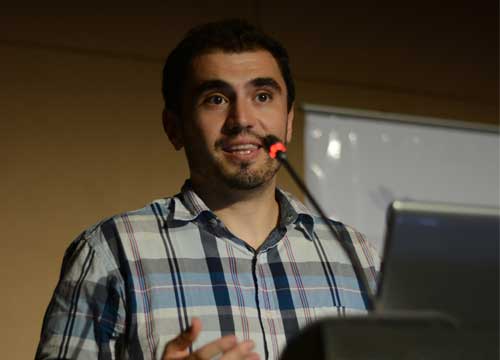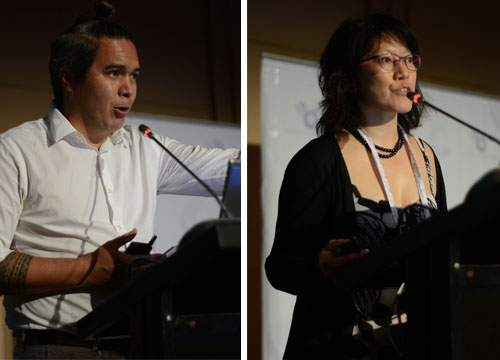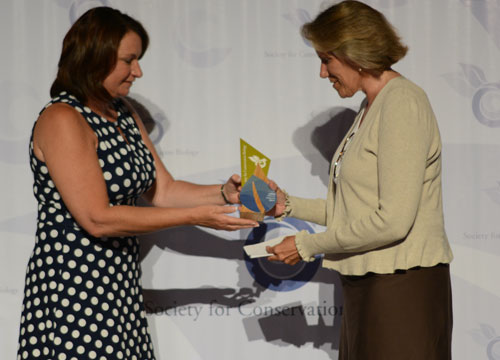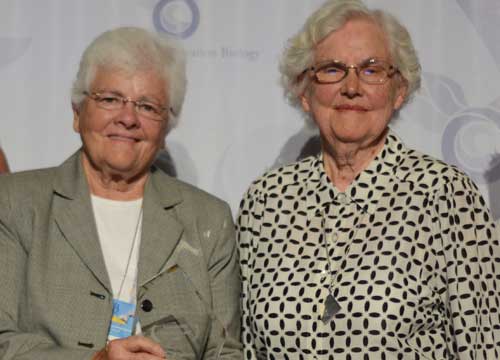Six conservationists received high honors from the Society for Conservation Biology for outstanding contributions to biodiversity protection at a special awards ceremony at the Society's 2017 International Congress for Conservation Biology in Cartagena, Colombia (23-27 July 2017).
Father Hermann Borg, a Franciscan missionary and founder of Mother Earth Network, received a Distinguished Service Award for his work in Kenya that has resulted in the planting of more than one million trees since 1987.
“We started to plant trees in Subukia 30 years ago," Father Borg said. "We did not know what we would achieve, we just started to do it. These one million trees have now grown tall and have changed the climate and improved the livelihoods of the people.”
 |
|
Father Hermann Borg accepts an SCB Distinguished Service Award at ICCB 2017 from SCB Past President James Watson (left) and SCB Executive Diretor Dr. Debborah Luke. |
Angelo O'Connor Villagomez, a biologist and environmental policy expert, received a Distinguished Service Award for his work on ocean conservation. Mr. Villagomez, the Pew Bertarelli Ocean Legacy Officer at the Per Charitable Trusts, helped to establish the Marianas Trench Marine National Monument and was instrumental in the successful campaign to expand the Papahānaumokuākea Marine National Monument, the world's largest marine protected area. He has also helped to design 15 international shark sanctuaries.
"It takes a special person who is groomed in this kind of cultural lifestyle and practice to know the importance and contributions that can be made to advance our need for marine protected areas and the restoration of marine resources," Solomon P. Kaho 'ohalahala of the Maui Nui Makai Network said of Angelo's contributions to the Papahānaumokuākea Monument and ocean conservation.
Diogo Verissimo received the SCB Early Career Conservationist Award for his work in the development and use of marketing practices and techniques to support the delivery of high-impact conservation. The biologist turned social marketer focuses on the human side of the biodiversity conservation. He has applied his work to reduce demand for pangolins in China, build local support for Spix's macaw reintroduction in Brazil, and to mitigate human-wildlife conflict in Nepal, among other projects. He is currently designing campaigns to reduce demand for sea turtle meat in West Africa and is part of an initiative to reduce overfishing in Mozambique, Indonesia, the Philippines, and Brazil.
 |
|
SCB Early Career Conservationist Award winner Diogo Verissimo speaks at the 2017 SCB Service Awards Ceremony at ICCB 2017 in Cartagena, Colombia. |
"Diogo embodies that profile, being a tireless champion for the importance of social sciences in general and social marketing in particular," Mike Dombeck, Executive Director of the David H. Smith Conservation Research Fellowship Program, said in support of Diogo for the award.
The Society presented its first ever Conservation Beacon Award to Mimi Lam, Marie Curie Fellow, Centre for the Study of the Sciences and Humanities at the University of Bergen, for her work on seafood ethics, sustainability, policy and governance and the protection of cultural and natural marine resources.
The Beacon Award recognizes emerging women leaders in conservation, particularly those who have overcome socio-economic, cultural and political barriers.
Mimi focuses on human-environment interactions to research values, ethics, and policy. She was honored for her work towards collaborative solutions for the Haida Gwaii Herring Fishery in British Columbia, Canada through the incorporation of values and ecosystem-based science in Pacific herring management. She leads several community-based research projects partnering with First Nations, NGOs, and the fishing industry to explain the cultural, ecological, and socio-economic values of Pacific herring.
"Mimi is making pioneering advances in conservation, defining the nascent field of seafood ethics to develop and apply robust ethical analyses to resource management and food security in local and global contexts," said Matthias Kaiser, Director of the Centre for the Study of the Sciences and the Humanities at the University of Bergen, in support of Mimi's nomination for the award.
 |
|
Distinguished Service Award winner Angelo O'Connor Villagomez and Conservation Beacon Award winner Mimi Lam speak at the 2017 SCB Service Awards Ceremony at ICCB 2017 in Cartagena, Colombia. |
Patricia Heglund, Chief of the Division of Natural Resources and Conservation Planning with the United States Fish and Wildlife Service’s Midwest Region (USFWS), received the Edward T. LaRoe III Memorial Award for her work in translating principles of conservation biology into on-the- ground conservation.
The LaRoe Award recognizes real-world conservation through the innovative application of science to resource management and policy. Patricia helped to design and promote Strategic Habitat Conservation, the USFWS’ current model for conducting conservation and management. She serves on the Refuge System’s Natural Resources Leadership Team, which oversees all biological policies and implementation for refuges, including developing the strategic plan for the National Inventory and Monitoring Program.
"Dr. Heglund is a bridge-builder," said Michael Scott, Professor Emeritus at the University of Idaho. "She has been very effective at promoting and improving partnerships between researchers and managers throughout her career. Pat’s work has made a significant difference in the type and quality of research conducted on wildlife refuges."
 |
|
Patricia Heglund receives the 2017 SCB LaRoe Award, which recognizes the innovated application of science to resource management and policy and is typically given to public service employees. Patricia has worked as a federal scientist with the United States Fish and Wildlife Service for more than 20 years. |
Finally, the Society's Religion and Conservation Biology Working Group presented the first ever Assisi Award for Faith-based Conservation to Holy Wisdom Monastery of Middleton, Wisconsin.
The award acknowledges organizations and individuals whose work demonstrates that faith-based conservation is contributing significantly to the common global effort of conserving life on Earth.
The Monastery was represented in Cartagena by Sister Mary David Walgenbach, prioress of Holy Wisdom Monastery and co-founder of the 1st Ecumerical Benedictine Community of Sisters in the United States. “The Sisters and the women and men who support the Holy Wisdom Monastery are deeply honored to receive the Assisi Award," she said in a press release announcing the award.
 |
|
Sisters Mary David Walgenbach (left) and Joanne Kollasch of the Holy Wisdom Monastery at ICCB 2017. The Monastery is the recipient of the first ever Assisi Award for Faith-based Conservation from the Society's Religion and Conservation Biology Working Group. |
The Holy Wisdom Monastery is an ecumenical Benedictine community with a mission to weave prayer, hospitality, justice and care for the earth into a shared way of life. The Monastery is home to the Wisdom Prairie Project, a restored 53-acre native prairie and oak savanna that will reduce phosphorus buildup in area lakes. The sisters also received LEED-Platinum certification for their new monastery building.